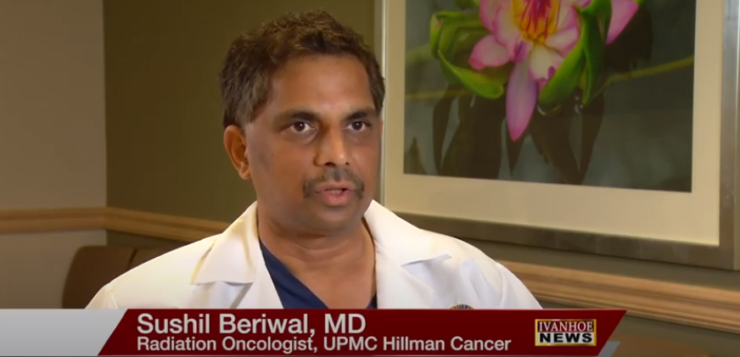Sushil Beriwal, MD, Radiation Oncologist at UPMC Hillman Cancer Center, talks about a method of treatment for breast cancer patients that would reduce the need for radiation exposure.
You and your colleagues are looking at radiation therapy for breast cancer patients. Can you tell me a little bit more?
BERIWAL: So, we are not doing the phase three trial, the phase three trial came out from the group in Italy last year, and basically it showed that in select subset of women with breast cancer the five fraction treatment is similar in outcome to 20 or 30 fraction treatment with less acute side effect, less chronic side effect, and no difference in breast cancer outcomes.
Now, you said the five-fraction treatment. Could you explain for me, for our viewers who may not be familiar, what that is?
BERIWAL: When the patient gets breast cancer treatment, they come daily for the treatment. So, each visit is counted as a fraction. In this regimen of five fractions, they come five times instead of, like, 20 or 30 times they had to come in the past.
And is it still the same period of time for each visit? And is the therapy essentially the same?
BERIWAL: So, I would say that, more or less, very close to other. There’s not much of a difference between the daily treatments. And the therapy, for the patient perspective, is very same, just the way it is technically done is a bit different.
And could you describe what is different?
BERIWAL: One of the ways for five fraction is instead of treating the whole breast, we treat part of the breast where surgery is done. So, since we treat part of the breast, we focus the beam of treatment to that part of the breast and try to avoid being – going to the other part of the breast. So, it’s more pinpoint or more conformal treatment focusing on part of the breast.
So, would it be correct to call it very focused?
BERIWAL: Yes. You can say it’s more focused than the whole breast radiation therapy.
How do you select which patients? Is this good for all breast cancer patients or which patients does this seem to work best for?
BERIWAL: So, this is for women who have early stage breast cancer and undergo lumpectomy. So, it’s not for women with node-positive breast cancer, it’s for node-negative ER-positive early stage breast cancer, which is not a small number of women which we see for breast cancer.
I know it sounds like a silly question, but really, what is the benefit for it for women to to be able to consider this over five days?
BERIWAL: One is, without compromising the cancer outcome, they can accomplish the task of radiation therapy in less visits, so less both social and financial burden on the women. And secondly, it appears that the side effects on the women in terms of skin toxicity, both acute and chronic, is also less. So, it’s a win-win situation. If you’re a suitable candidate, it causes less physical discomfort, less financial stress, and less visits to the hospital.
And you had mentioned some of the side effects. Could you just, again, for our viewers who are not familiar, what are some of the side effects that a woman would be having after radiation?
BERIWAL: So they may have some irritation to the skin, something like darkening or skin pigmentation of skin, sometimes superficial peeling of skin. All of those are less because we are treating less tissue.
I know that some women may be concerned, gee, if I’m just coming those five days, is it really enough?
BERIWAL: So it is because that’s where the randomized data comes out. And the long-term 10-years data suggest that this shorter course of treatment is very similar in outcome to the three weeks or four weeks of treatment. And this is not one study. There are other studies which have shown similar outcomes with partial breast radiation.
So, this study that came out of Italy, is this practice-changing for you and your colleagues? Are you looking at implementing this now? And will this become the gold standard?
BERIWAL: So, yes, it is practice-changing. Not for all, but for some. And we have started doing it since the study came out. And now we are implementing this across our network of the UPMC Hillman Cancer Center. For any woman who is suitable for this kind of treatment should be considered for this treatment.
And you said, again, early stage, so that would be which stages?
BERIWAL: It’s usually stage one and early stage two.
And is this usually done in conjunction with chemotherapy or with other therapies?
BERIWAL: So those therapies are independent of each other like, breast radiation therapy is integral part of lumpectomy. They may, in addition to radiation, also get some kind of systemic treatment, which could be anto estrogen therapy or chemotherapy depending on the cancer type, but that would not influence what we do with radiation.
OK. Is there anything I didn’t ask you, doctor, that you would want women and their families to know?
BERIWAL: It’s just the fact that the field of breast radiation therapy is heading towards being more individualized and personalized. Like, in the past, we used to have one-size-fit model. Everybody used to get 30 treatments. Now the option for treatment could be five treatments, 15 treatments or 30 treatments based on the extent of disease and the type of operation.
And when you said you started implementing it here in Pittsburgh after that trial came out?
BERIWAL: The 10-years data was presented at San Antonio in December last year. And it was published this year, but the data was presented last year in December.
And when did you start making the change here?
BERIWAL: Last year.
Have you seen a difference, just anecdotally?
BERIWAL: We hardly see any skin toxicity in these women when we treat with partial breast five fraction treatment. And when they come back for the up, they hardly have any effect of radiation therapy. And that’s what this data and the study showed when it was published.
Interview conducted by Ivanhoe Broadcast News.
END OF INTERVIEW
This information is intended for additional research purposes only. It is not to be used as a prescription or advice from Ivanhoe Broadcast News, Inc. or any medical professional interviewed. Ivanhoe Broadcast News, Inc. assumes no responsibility for the depth or accuracy of physician statements. Procedures or medicines apply to different people and medical factors; always consult your physician on medical matters.
If you would like more information, please contact:
Cyndy Patton
412-415-6085
Sign up for a free weekly e-mail on Medical Breakthroughs called First to Know by clicking here




